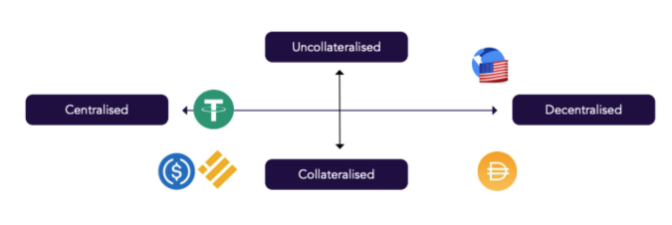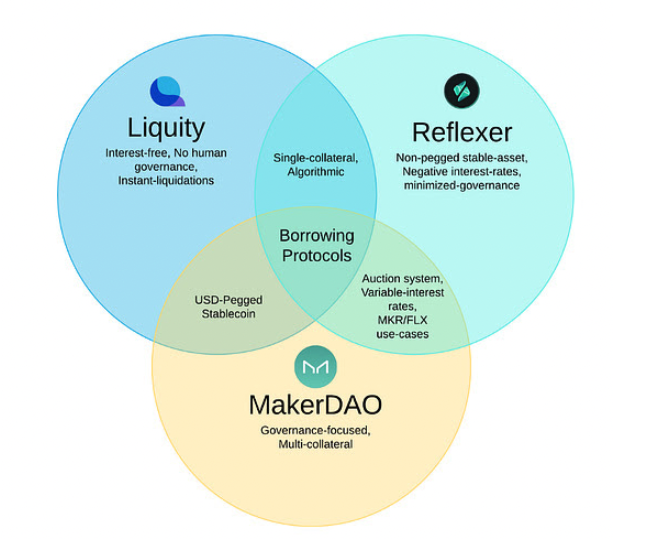
Read the full article
Liquity is a decentralized borrowing protocol that allows users to take out interest-free loans against Ether (ETH) deposits. The protocol is designed to be fully autonomous, with no admin keys or governance. Loans are paid out in the protocol's native stablecoin, LUSD, which is pegged to the US dollar.
LUSD is a stablecoin introduced by the Liquity Protocol, a decentralized borrowing platform that allows users to issue interest-free loans against Ether (ETH) collateral. The stablecoin is designed to maintain a value of approximately $1, with an algorithmic monetary policy mechanism ensuring its stability.
Other notable Liquity features include:
- Non-custodial - users retain full control of their assets at all times.
- Permissionless - anyone can participate, regardless of their technical expertise.
- Decentralized - not controlled by any single entity.
Strengths
- Governance free
- Fully decentralized collateral + UI
- Instant liquidation
- Lower liquidation level than competitors like Maker
Important Links
- Official Liquity Documentation
- Dashboard
Liquity is a decentralized borrowing protocol that offers interest-free loans against Ether used as collateral. Designed to tackle the centralization issue in the stablecoin market, Liquity aims to make borrowing more capital-efficient and user-friendly, while maintaining a fully decentralized and governance-free system.
Stable-value assets are vital for Ethereum applications and have grown to represent tens of billions of dollars in value. However, most of this value is centralized in fiat-collateralized stablecoins like Tether and USDC. Decentralized stablecoins, such as DAI and sUSD, make up a smaller portion of the total supply. Liquity addresses this imbalance by creating a more efficient and decentralized way to borrow stablecoins without governance interference.
Liquity offers several benefits that make it stand out from traditional borrowing platforms:
- 0% interest rate: Borrowers don't need to worry about accruing debt.
- Minimum collateral ratio of 110%: Efficient usage of deposited ETH as collateral.
- Governance-free: Fully automated operations and algorithmic protocol parameters set at contract deployment.
- Directly redeemable: LUSD can be redeemed for the underlying collateral at face value.
- Fully decentralized: No admin keys and accessible via multiple front-end operators, ensuring censorship resistance.
Using Liquity
To access Liquity, users need to choose a web interface (front end) operated by third-party applications or integration services. The core team behind the protocol does not operate a front end, promoting decentralization and avoiding central points of control.
Liquity offers various use cases, including:
- Borrowing LUSD against ETH by opening a Trove.
- Securing Liquity by providing LUSD to the Stability Pool in exchange for rewards.
- Staking LQTY to earn fee revenue paid for borrowing or redeeming LUSD.
- Redeeming 1 LUSD for 1 USD worth of ETH when the LUSD peg falls below $1.
LUSD and LQTY Tokens
LUSD is a USD-pegged stablecoin used to pay out loans on the Liquity protocol. It can be redeemed against the underlying collateral at face value. LQTY is the secondary token issued by Liquity, with a capped supply of 100,000,000 tokens. It captures fee revenue generated by the system and incentivizes early adopters and frontends.
To borrow LUSD, users need a wallet (e.g., MetaMask) and sufficient Ether to open a Trove and pay gas fees. To become a Stability Pool depositor or LQTY staker, users need LUSD and/or LQTY tokens, which can be obtained by opening a Trove, participating in the Stability Pool, or purchasing them on a decentralized exchange.
Liquity charges a one-off borrowing fee on loans as a percentage of the drawn amount (in LUSD) and a redemption fee on the amount paid to users (in ETH) when exchanging LUSD for ETH. These fees depend on redemption volumes, increasing upon every redemption and decaying over time as long as no redemptions occur. The borrowing fee is capped at 5%, while the minimum fee is 0.5%, which prevents misuse by arbitrageurs front-running the price feed.
Key Features of LUSD:
- Interest-free loans: One of the primary use cases of LUSD is to enable users to take out interest-free loans. Borrowers can deposit ETH as collateral and mint LUSD, which they can then use within the DeFi ecosystem or convert to other stablecoins or cryptocurrencies.
- Stability mechanisms: To maintain LUSD's peg to the US dollar, the Liquity Protocol employs a set of mechanisms that adjust the system's parameters. These adjustments incentivize users to either mint or redeem LUSD depending on the stablecoin's current price. For instance, if LUSD is trading above $1, users are encouraged to mint new tokens, increasing the supply and pushing the price down. Conversely, if LUSD is trading below $1, users can redeem their tokens for collateral, reducing the supply and pushing the price up.
- Decentralized governance: LUSD operates under a decentralized governance model, with token holders having the power to influence protocol decisions. This approach promotes transparency and community involvement, ensuring that the protocol evolves in line with the preferences of its users.
- Integration with DeFi platforms: LUSD is designed to be compatible with various DeFi platforms, allowing users to access a wide range of financial services such as lending, borrowing, trading, and staking.
How LUSD differs from other stablecoins:
Not all stablecoins are created equal! There are several different approaches projects have taken to keep their stablecoin "stable.” By far, the easiest approach (and therefore most popular) is backing a crypto stablecoin 1:1 with fiat dollars/dollar equivalents in a bank. This is the approach market leaders have taken. For every USDC in circulation, there's $1 (or dollar equivalent) in reserves with the Circle Consortium. There are also stablecoins like PAXG backed by the equivalent amount in gold. While these are the current market leaders, fiat-backed stablecoins inherit all of the issues that come with fiat plus require trust in a centralized custodian. This isn't exactly the revolution crypto promised!
Because of this, over-collateralized stablecoins, such as and others were created. These stablecoins are over-collateralized with another cryptoasset (usually at a ~1.5:1 ratio), ensuring you can always redeem one unit of their stablecoin from the collateral’s value. If the collateral’s value drops below the liquidation level (varies depending on the protocol), the collateral is sold to ensure no losses are sustained. While these stablecoin solutions generally hold their peg, they can suffer in times of high volatility due to cascading liquidations. Liquity and LUSD fall into this category.
 Source: Chain Debrief
Source: Chain Debrief
Finally, algorithmic stablecoins—which have been around for years, but only really began gaining adoption after 2020—use algorithms to control the stablecoin peg and the underlying tokenomics. Generally speaking, algorithmic stablecoins are run by pre-programmed intelligent contracts that execute specific actions to maintain the peg. They usually exhibit some or all of the following properties:
- No outside collateral backing the token
- Partially/fully-collateralized by a native token
- Floating peg (e.g. RAI)
While there are several stablecoins in the DeFi ecosystem, LUSD stands out due to its unique characteristics:
- Interest-free loans: Unlike other stablecoins, LUSD enables users to take out loans without incurring interest. This feature sets it apart from platforms like MakerDAO, which charge a stability fee on DAI loans.
- Algorithmic monetary policy: LUSD's stability mechanisms rely on an algorithmic monetary policy, making it less dependent on centralized entities for price stabilization. In contrast, stablecoins like USDC and USDT are backed by collateral held in centralized reserves.
- Community-driven governance: LUSD's decentralized governance model encourages community participation, whereas other stablecoins may be governed by a centralized entity or a select group of stakeholders.
 Source: Chain Debrief
Source: Chain Debrief
Competitive Advantages
The recent destabilization of USDC and the ongoing legal tussle between Paxos, the issuer of BUSD, and the Securities and Exchange Commission (SEC), have underscored the growing significance of stablecoins backed by fully on-chain collateral. This trend is evidenced by the consistent surge in demand for LUSD since March 11, a phenomenon reflected in the overall LUSD supply which swelled by over 50% in the first quarter. Notably, LUSD was one of the select stablecoins to register growth during this period.
The struggles confronting centralized stablecoin issuers like Paxos and Circle emanate from multiple counterparty risks and stringent regulatory oversight. These challenges underscore the importance of censorship-resistant alternatives such as LUSD, which provide a degree of operational freedom and resilience in the face of an uncertain regulatory environment.
Liquity's growth trajectory has been further bolstered by its recent listing on Binance. Being perceived as a favored substitute for Paxos on the platform, this development has driven the price of LQTY sharply upwards, leading to increased adoption of Liquity's offering. The enhanced exposure and accessibility facilitated by BINANCE have invariably positioned Liquity for greater growth and user engagement in the cryptocurrency landscape.











